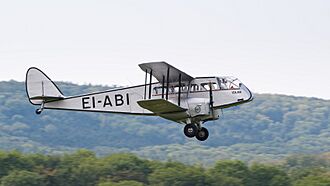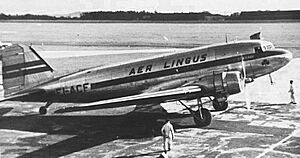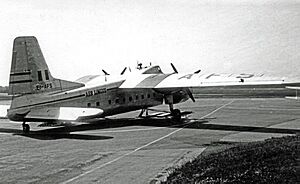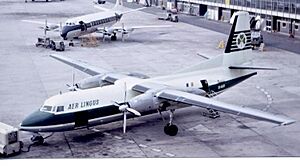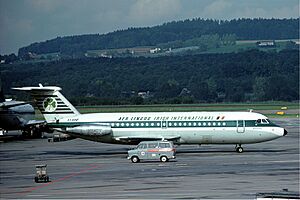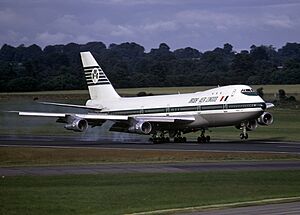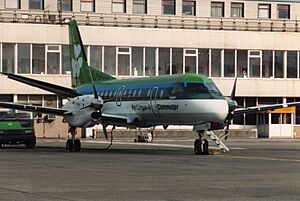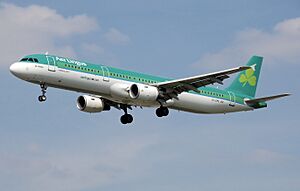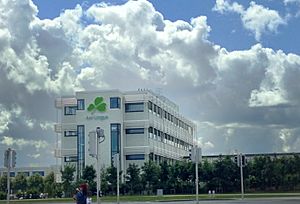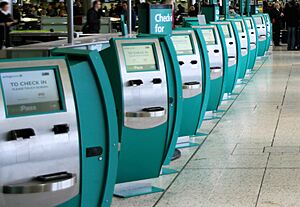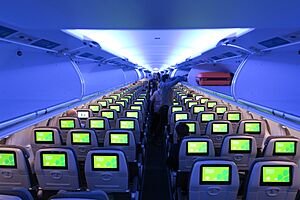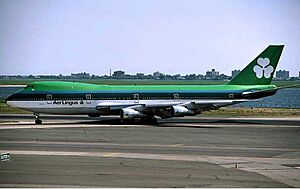Aer Lingus facts for kids

An Airbus A320 of Aer Lingus
|
|
| Founded | 15 April 1936 |
|---|---|
| Commenced operations | 28 May 1936 |
| Hubs | Dublin Airport |
| Focus cities | Cork Airport |
| Frequent-flyer program |
|
| Subsidiaries |
|
| Fleet size | 58 (Including Aer Lingus UK) |
| Destinations | 97 |
| Parent company | International Airlines Group |
| Headquarters | Cloghran, County Dublin, Ireland |
| Key people | Lynne Embleton (CEO) |
| Revenue | |
| Operating income | |
| Net income | |
| Employees | 4,500 approx (2020) |
Aer Lingus is an Irish airline. It is known as the "flag carrier" of Ireland, which means it's the main airline representing the country. The name "Aer Lingus" comes from the Irish words for "air fleet."
The airline was started by the Irish Government in 1936. Later, it became a private company. Now, it is owned by International Airlines Group (IAG), which also owns other airlines like British Airways. Aer Lingus's main office is located near Dublin Airport in Cloghran, County Dublin.
Aer Lingus used to be part of a big airline group called Oneworld. However, it left that group in 2007. Even though it's not part of Oneworld anymore, Aer Lingus works with many other airlines. This helps passengers connect to more places around the world. The airline offers different types of flights. For flights within Europe, it has a mix of low-cost and regular services. For longer flights across the Atlantic Ocean, it offers full service with two different seating classes.
Before IAG bought Aer Lingus, another airline called Ryanair owned a large part of it. The Irish government also owned a share. In 2015, IAG bought out both the government's and Ryanair's shares. This made Aer Lingus a full part of the IAG group.
Contents
- How Aer Lingus Started
- How Aer Lingus Works
- Where Aer Lingus Flies
- Aer Lingus Planes
- What Aer Lingus Offers
- Plane Incidents
- More to Explore
- See also
How Aer Lingus Started
The Beginning
Aer Lingus began on April 15, 1936. Its first chairman was Seán Ó hUadhaigh. The airline was officially registered on May 22, 1936. The name Aer Lingus was suggested by Richard F O'Connor, who loved aviation.
Just five days after being registered, on May 27, 1936, Aer Lingus started its first flight. This flight went from Baldonnel Airfield in Dublin to Bristol (Whitchurch) Airport in the United Kingdom. The plane used was a small, six-seater de Havilland DH.84 Dragon biplane. It was named Iolar, which means "Eagle."
Later that year, the airline got a second plane, a larger, four-engine de Havilland DH.86 Express called "Éire." This plane could carry 14 passengers. It helped create the first air link between Dublin and London by extending the Bristol service. At the same time, the "Iolar" plane started a new route between Dublin and Liverpool.
In 1937, the Irish government created a company called Aer Rianta (now Dublin Airport Authority). This company was in charge of the airline's money and all of Ireland's airports. By April 1937, Aer Lingus was fully owned by the Irish government through Aer Rianta.
In 1938, a newer de Havilland DH.89 Dragon Rapide replaced "Iolar." The airline also bought two Lockheed 14s in 1939. These were Aer Lingus's first planes made entirely of metal.
In January 1940, a new airport opened in Dublin called Collinstown. Aer Lingus moved its flights there. It bought a new DC-3 plane and started new flights to Liverpool and an internal flight to Shannon. During World War II, the airline's flights were limited. The only route available was to Liverpool or Manchester, depending on how safe it was.
Growing After the War
On November 9, 1945, regular flights started again with a flight to London. From then on, Aer Lingus planes, mostly Douglas DC-3s, were painted in silver and green. This was also when the airline hired its first flight attendants.
In 1946, a new agreement gave Aer Lingus special rights for flights between Ireland and the UK. In return, British airlines like BOAC and BEA owned 40% of Aer Lingus. As Aer Lingus grew, it bought seven new Vickers Viking planes in 1947. However, these planes were not cost-effective and were soon sold.
In 1947, a new airline called Aerlínte Éireann was created. Its goal was to fly across the Atlantic Ocean to New York City. The airline ordered five new Lockheed L-749 Constellations. However, a change in government and money problems stopped these flights from starting.
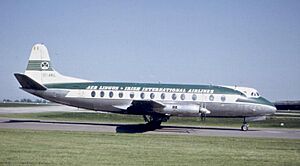
In the late 1940s and early 1950s, Aer Lingus added flights to Brussels, Amsterdam, and Rome. Because it was flying to more places, the airline was one of the first to buy Vickers Viscount 700 planes in 1951. These started flying in April 1954. In 1952, the airline also expanded its cargo services and bought a small group of Bristol 170 Freighter planes.
In 1956, Aer Lingus introduced a new look for its planes. They had a green top, a white lightning bolt design, and the Irish flag on the tail.
First Flights Across the Atlantic
On April 28, 1958, Aerlínte Éireann made its first flight across the Atlantic. It flew from Shannon to New York. In 1960, Aerlínte Éireann changed its name to Aer Lingus.
Aer Lingus bought seven Fokker F27 Friendship planes between 1958 and 1959. These planes were used for shorter flights to the UK, replacing the older Dakotas.
The airline entered the "jet age" on December 14, 1960. It received three Boeing 720 jets for its flights to New York and its newest destination, Boston.
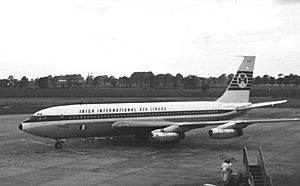
In 1963, Aer Lingus added Aviation Traders Carvair planes to its group. These planes could carry five cars inside them, which were loaded through the front of the aircraft. However, these planes were not very cost-effective for the airline.
The Boeing 720 jets were very successful for transatlantic flights. To add to these, Aer Lingus received its first larger Boeing 707 in 1964. This type of plane continued to fly for the airline until 1986.
The Jet Age Continues
In 1965, Aer Lingus started using jet planes for its European flights, beginning with the BAC One-Eleven. The airline also changed its look again that year, adding a large green shamrock to the tail of its planes.
In 1966, the company added new routes to Montreal and Chicago. In 1968, flights from Belfast, in Northern Ireland, to New York City began. However, these flights were soon stopped because of political problems in Northern Ireland.
Aer Lingus added Boeing 737 planes to its group in 1969. This was to handle the high demand for flights between Dublin and London. Later, Aer Lingus used the 737s for all its European flights.
In 1967, after 30 years of service, General Manager Dr J. F. Dempsey signed the contract for the airline's first two Boeing 747 planes. He retired later that year.
From the 1970s to the 1990s
On March 6, 1971, Aer Lingus received its first of two Boeing 747s. These large planes were used for transatlantic flights. The company later bought a third 747, but it was not always profitable to fly them across the Atlantic, so they sometimes leased it out. In 1974, Aer Lingus showed off a new look for its planes. It had a dark green line, light green on the top, and a large white shamrock on the tail.
In 1977, Aer Lingus hired its first female pilot, Gráinne Cronin. Aer Lingus was only the second airline in Europe to have female pilots.
In September 1979, Aer Lingus became the first European airline other than Alitalia to be used by Pope John Paul II. He flew on a specially changed Boeing 747 from Rome to Dublin and then from Shannon to Boston. In the early 1980s, the older 707 planes were gradually removed from service.
In 1984, the airline created a new company called Aer Lingus Commuter. This allowed Aer Lingus to fly to larger cities in Ireland and Britain that did not need jet planes. These services used five Short 360 planes. Around this time, Aer Lingus also bought a large share in a cargo airline called Aer Turas.
Between 1987 and 1989, new Boeing 737s arrived to replace the older ones. Six Fokker 50 planes were added to the Commuter group. In 1990, after new rules for airlines in Ireland, Aer Lingus changed its plans. It stopped using the BAC One-Elevens and replaced them with five new 737s. In 1991, four Saab 340Bs joined the commuter division. By 1992, Aer Lingus had replaced all its original 737-200 planes. It was the first airline in the world to use all three versions of the second-generation 737.
In 1994, Aer Lingus started direct flights between Dublin and the United States using the Airbus A330. This led to the older Boeing 747s being phased out. On October 2, 1995, the Boeing 747 flights stopped after 25 years of service. By then, over eight million people had flown across the Atlantic on Aer Lingus 747s. In the late 1990s, Aer Lingus returned to Belfast with flights to New York. It also added Newark Liberty International Airport as a destination, but these flights stopped in 2001.
The first Airbus short-haul planes arrived in 1998. These were the Airbus A321s, mainly used for the Dublin-Heathrow route. Six were delivered in 1998 and 1999. The first Airbus A320 arrived in 2000, with three more by 2001.
From the 2000s to the 2010s
On February 1, 2001, Aer Lingus Commuter became part of the main airline again. The airline was greatly affected by the 9/11 attacks in the United States. In response, Aer Lingus reduced its staff and destinations. It also made its group of planes smaller. Because of these changes, it managed to make a profit again. This was mostly by lowering costs and using modern Airbus planes. Aer Lingus also started new routes to European destinations. It began to compete with "no-frills" airlines in Europe while still offering long-distance flights.
Many new A320 planes were delivered from 2004 to 2011. These new planes allowed Aer Lingus to stop using its Boeing 737s. On October 29, 2005, Aer Lingus stopped using its last two 737 planes. This meant that Aer Lingus now only flew Airbus planes.
On October 27, 2005, Aer Lingus announced its first flights to Asia, starting in March 2006, to Dubai International Airport in the United Arab Emirates. This service stopped in March 2008.
On June 6, 2007, Aer Lingus ordered six new A350-900 and six A330-300 planes from Airbus. These were meant to help the airline expand its long-haul flights and replace older planes. Deliveries of the A330s began in February 2009.
Becoming a Public Company
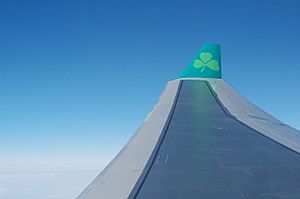
To prepare for Aer Lingus to be sold on the stock market, the Irish government agreed to remove the "Shannon Stopover" rule. This rule meant that all flights between Ireland and the US had to stop at Shannon Airport.
The company's shares started trading on September 27, 2006. It was officially listed on the Irish Stock Exchange and London Stock Exchange on October 2, 2006. At that time, the Irish government still owned 28% of the shares, and employees owned 15%.
Aer Lingus left the Oneworld airline group on March 31, 2007. It decided to work directly with other airlines instead, like British Airways and United Airlines. Aer Lingus said it wanted to be a low-cost airline, which didn't fit with Oneworld's focus on frequent flyers.
Expanding Across Borders
On August 7, 2007, Aer Lingus announced it would open its first base outside Ireland at Belfast International Airport in Northern Ireland. Flights from Belfast International started in December 2007. By July 2008, the airline had three Airbus A320 planes based there, flying to eleven European cities. This move brought back flights between Belfast International and London Heathrow Airport. Aer Lingus worked with British Airways on this route. To do this, the airline stopped its Shannon-Heathrow service, which caused some debate. The Shannon to Heathrow service has since been restarted.
After five years at Belfast International Airport, Aer Lingus moved its operations to George Best Belfast City Airport on July 19, 2012. It moved its Belfast – London Heathrow flights there.
New Flights to the US
On March 22, 2007, because of a new "Open Skies Agreement" between the EU and the US, Aer Lingus announced three new long-haul flights to the United States. From Autumn 2007, Aer Lingus started direct flights to Orlando, San Francisco, and Washington, D.C.-Dulles. This was possible because two new Airbus A330 planes arrived in May 2007. The airline also flies to Boston, Chicago, and New York. The Washington D.C. and San Francisco routes were stopped in October 2009 but later restarted. Flights to Los Angeles, Newark, Miami, Philadelphia, and Seattle all started between 2015 and 2018. Flights from Dublin to Minneapolis started in 2019 and are set to resume in April 2024.
On March 24, 2021, Aer Lingus announced four new routes from Manchester Airport. These included flights to New York and Orlando starting in July 2021, Barbados in October 2021, and Boston in summer 2022.
Changes During the 2008 Recession
After losing money in the first half of 2008, Aer Lingus announced a plan to save money in October 2008. This plan included cutting up to 1,500 jobs and changing how ground operations worked at Cork and Dublin Airports. This plan was not popular with trade unions.
In December 2008, Aer Lingus announced that the Shannon – Heathrow service would start again in March 2009. This was after new agreements with unions and the Shannon Airport Authority. However, by June 2009, the company had lost a lot of money. In October 2009, the new CEO, Christoph Mueller, announced a big plan to cut costs. This plan would lead to 676 job losses and lower pay for those who stayed.
Ryanair's Attempts to Buy Aer Lingus
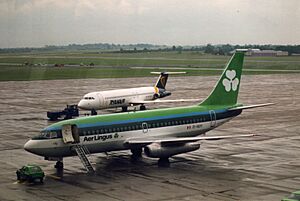
On December 1, 2008, Ryanair tried for a second time to buy Aer Lingus. Ryanair offered €748 million. Ryanair said that Aer Lingus was too small on its own. They claimed that if they bought Aer Lingus, they would double its short-haul planes and create 1,000 new jobs. The Aer Lingus Board said no to the offer. The offer was eventually rejected by most other shareholders. This was the second time Ryanair's CEO, Michael O'Leary, tried and failed to buy Aer Lingus.
On June 19, 2012, Ryanair announced its intention to try again to buy Aer Lingus. They offered €1.30 per share. On June 20, 2012, Aer Lingus again rejected the offer. They said that the European Commission had blocked Ryanair's previous attempt in 2007. They also believed Ryanair's offer was too low.
On February 27, 2013, the European Commission blocked Ryanair's third attempt to buy Aer Lingus. They said that if the two airlines joined, it would reduce choices for customers and make prices higher.
Partnership with Virgin Atlantic
In December 2012, Virgin Atlantic was given permission to fly domestic routes within the UK from Heathrow Airport. Aer Lingus provided four Airbus A320 planes and crew for these flights. The planes were painted in Virgin's colors but kept their Irish registration. These services started on March 31, 2013, to Manchester. This partnership ended in September 2015.
More Long-Haul Flights
In July 2013, Aer Lingus announced more flights to North America starting in 2014. This included a direct flight from Dublin to San Francisco five times a week. There was also a daily flight from Dublin to Toronto. Transatlantic flights from Shannon to Boston and New York would also operate daily all year round. Aer Lingus started using Boeing 757 planes for these routes. Flights to Washington Dulles airport restarted in May 2015. Flights to Los Angeles, Newark, Miami, Philadelphia, and Seattle all started between 2015 and 2018. Flights from Dublin to Minneapolis started in 2019.
On March 24, 2021, Aer Lingus announced four new routes from Manchester Airport. These included flights to New York and Orlando from July 2021, Barbados from October 2021, and Boston from summer 2022.
New Leaders
On July 18, 2014, it was announced that CEO Christoph Mueller would leave in May 2015. He left to join Malaysia Airlines. On February 16, 2015, Stephen Kavanagh was announced as the new CEO, starting March 1, 2015. On January 1, 2019, Sean Doyle became the new Aer Lingus CEO. As of April 6, 2021, Lynne Embleton became the new Aer Lingus CEO.
IAG Takes Over
On December 14, 2014, International Airlines Group (IAG) offered to buy Aer Lingus for €1 billion. The Aer Lingus Board said no on December 16, 2014. They said the offer was too low.
On January 9, 2015, Aer Lingus rejected a second offer from IAG. On January 24, 2015, IAG made a third offer for Aer Lingus, proposing €2.55 per share, totaling almost €1.4 billion. On January 27, 2015, Aer Lingus's board announced that they would recommend IAG's third offer. They noted that IAG planned for Aer Lingus to operate as a separate business with its own brand and management.
On May 26, 2015, the Irish Government agreed to sell its 25% share to IAG. On July 10, 2015, Ryanair also agreed to sell its nearly 30% share in the airline. The takeover was approved by regulators. On September 2, 2015, IAG took control of Aer Lingus. On September 17, 2015, Aer Lingus's shares were removed from the Irish and London Stock Exchanges.
The 2020s
On February 25, 2020, Aer Lingus was told by the Irish government that there were travel restrictions to some Italian towns because of COVID-19. However, Aer Lingus said all flights would continue to operate safely.
On February 28, Aer Lingus learned that a passenger with COVID-19 had been on a flight from Milan to Dublin. Four Aer Lingus cabin crew members from that flight had to self-isolate. The next day, Aer Lingus stopped flights to Northern Italy. By March 10, all flights to Italy were suspended.
On March 13, Donald Trump, who was President of the United States, announced a travel ban from Europe. This ban was extended to Ireland the next day. Aer Lingus then greatly reduced its flights, cutting its network by 95%. The airline had planned its biggest summer schedule ever, but the global pandemic stopped it. As a temporary measure, the airline cut hours and salaries for all employees by 50%.
Later that month, on March 29, an Aer Lingus flight from Beijing, China, landed at Dublin Airport. It was carrying important PPE for Ireland's healthcare workers. This was the start of many flights the airline operated for the Irish government to bring in supplies.
With only 5% of its flights operating, Aer Lingus announced on May 1, 2020, that it needed to cut 900 jobs. The airline talked with trade unions about changes to work and job cuts. Aer Lingus CEO Sean Doyle said it would take years for the airline industry to recover. Job cuts were confirmed later that month. Temporary staff were let go, and cabin crew in Shannon were temporarily laid off.
In June 2021, the airline said it wanted to freeze workers' pay for five years. It also suggested big cuts in pay rates for new cabin and crew staff.
In 2024, IAG announced that Aer Lingus would not be the first airline in the world to use the Airbus A321XLR as planned. Because of ongoing disagreements with workers, the first plane would go to another airline, Iberia, instead.
On October 23, 2024, it was reported that Aer Lingus would start a new direct flight between Dublin and Indianapolis, beginning May 3, 2025. This is a big step for the airline, as there are currently no direct flights to Indiana's capital city. Aer Lingus will offer four flights per week using its Airbus A321XLR planes.
In January 2025, a lawsuit from 1997 was dismissed. The court found the claims against Aer Lingus were unfair and ordered the Airports Authority of India to pay Aer Lingus money for costs and expenses.
How Aer Lingus Works
Business Information
Aer Lingus's business has changed over the years. Here are some key facts:
| Year | Total Money Made (€m) |
Profit (€m) |
Number of Employees |
Number of Passengers (millions) |
Seats Filled (%) |
Number of Planes |
|---|---|---|---|---|---|---|
| 2007 | 1,284 | 105 | 3,905 | 9.3 | 75.4 | 41 |
| 2008 | 1,357 | −107 | 4,035 | 10.0 | 72.8 | 42 |
| 2009 | 1,205 | −130 | 3,844 | 10.4 | 74.5 | 44 |
| 2010 | 1,215 | 43.0 | 3,516 | 9.3 | 76.1 | 44 |
| 2011 | 1,288 | 71.2 | 3,491 | 9.5 | 75.6 | 43 |
| 2012 | 1,393 | 33.9 | 3,566 | 9.7 | 77.7 | 44 |
| 2013 | 1,425 | 34.1 | 3,615 | 9.6 | 78.4 | 47 |
| 2014 | 1,557 | −95.8 | 3,766 | 9.8 | 79.0 | 50 |
| 2015 | 1,718 | 118 | 2,753 | 10.1 | 81.6 | 49 |
| 2016 | 1,766 | 205 | 2,711 | 10.4 | 81.6 | 51 |
| 2017 | 1,859 | 234 | 2,662 | 10.9 | 81.2 | 53 |
| 2018 | 2,020 | 258 | 2,658 | 11.3 | 80.9 | 56 |
| 2019 | 2,125 | 225 | 2,646 | 11.6 | 81.8 | 58 |
| 2020 | 467 | −502 | 1,609 | 2.1 | 46.4 | 56 |
| 2021 | 366 | −338 | 2,472 | 2.0 | 48.0 | 57 |
| 2022 | 1,667 | −23.0 | 2,283 | 9.0 | 77.0 | 56 |
| 2023 | 2,147 | 169 | 2,279 | 10.8 | 81.0 | 57 |
Ownership
Aer Lingus used to be listed on the Irish and London Stock Exchanges. However, it was removed from these lists on September 17, 2015, after IAG bought most of its shares. As of September 2, 2015, IAG owned most of Aer Lingus.
| Owner | Percentage Owned |
|---|---|
| International Airlines Group | 98.05% |
| Other investors | 1.95% |
| Total | 100.00% |
Aer Lingus Cargo
Aer Lingus Cargo is the part of the airline that carries goods. It uses special areas in the cargo holds of passenger planes. Aer Lingus Cargo is available on all flights to the US from Dublin and Shannon. It also offers cargo services on most European and some UK routes. This division later became part of IAG Cargo.
Aer Lingus Regional
Aer Lingus Regional flights are operated by another airline called Emerald Airlines. They fly under the Aer Lingus Regional brand and flight code. Before Emerald Airlines, these flights were operated by Stobart Air.
How the Business Works
Aer Lingus uses a "small frills" approach. This means it's a mix between a traditional airline and a low-cost carrier. The services offered are different for short flights and long flights. For example, meals are only free on long-haul flights.
This new way of working required a lot of talks with the unions (groups that represent workers). Everyone agreed that lower costs were needed for the airline to survive. These changes helped the airline make a profit in many years.
Main Office
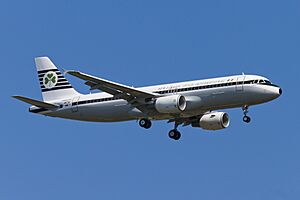
The Aer Lingus main office is located at Dublin Airport in Fingal, County Dublin. The Dublin Airport Authority (DAA) updated an existing building for Aer Lingus's headquarters.
The old head office site included several buildings. These buildings housed the main office, training facilities for crew, and other administrative areas. In 2010, Aer Lingus announced that it would move its employees to other buildings. The airline said its old head office was too big after it reduced costs. In 2011, Aer Lingus signed a contract to give back the lease on its old head office building to the Dublin Airport Authority. The old head office site was then redeveloped into Dublin Airport Central.
Employee Relations
On May 30, 2014, Aer Lingus cabin crew went on a 24-hour strike. This caused about 200 flights to be cancelled and affected up to 200,000 people's travel plans. The workers wanted changes to their work schedules. The airline said that if these changes were made, it would mean 300 jobs in Ireland would be lost and moved to North America.
Sponsorships
Aer Lingus has sponsored several events. From 1989 to 1992, it sponsored the Irish Times International Fiction Prize.
On April 30, 2015, Aer Lingus became the official airline of the Irish Rugby Team. On the same day, it was announced that one plane would be renamed "Green Spirit" and painted with a special design for the Irish Rugby Team. Another plane would also get the same design.
Since 2016, Aer Lingus has sponsored the Aer Lingus College Football Classic. This is a gridiron football game played in Dublin's Aviva Stadium every August since 2022.
Where Aer Lingus Flies
As of June 2024, Aer Lingus flies to 93 places in Europe and North America. This includes countries like Austria, Belgium, Canada, France, Germany, Greece, Ireland, Italy, the Netherlands, Poland, Portugal, Spain, Switzerland, Turkey, the United Kingdom, and the United States.
In October 2022, Aer Lingus flights between Belfast City and London Heathrow were moved to Aer Lingus UK. This was because of new rules after Brexit, which meant a European airline could no longer fly domestic routes within the United Kingdom. These flights are now operated by British Airways using Aer Lingus UK flight numbers.
Main Bases
Aer Lingus has five main bases:
- Dublin – This is Aer Lingus's main base for almost all its long-distance flights across the Atlantic and other international routes. It also serves many European and UK routes. Dublin is also where the airline does most of its plane maintenance.
- Cork – Even though operations have been reduced, Cork is still an important base for Aer Lingus. Three planes are based there, flying to 10 places in the UK and Europe.
- Shannon – Aer Lingus uses Shannon as a smaller, secondary base. It offers short flights to London-Heathrow and Paris-Charles de Gaulle. These flights help connect passengers to its daily transatlantic flights to Boston and New York.
- Belfast – Flights from Belfast are mainly within the UK, but some international European flights also operate there. After Brexit, Aer Lingus focused more on UK flights from Belfast.
- Manchester – Aer Lingus bases two Airbus A330 planes here. It flies to Barbados, New York, and Orlando from its Manchester base.
Partner Airlines
Aer Lingus works with these airlines to offer more flight options:
- Air Canada
- Alaska Airlines
- American Airlines
- British Airways
- Iberia
- JetBlue
- Loganair
- Qatar Airways
- TUI Airways
- Vueling
Aer Lingus Planes
Current Planes
As of May 2025, Aer Lingus uses only Airbus planes. Here are the types of planes it has:
| Aircraft | In service | Orders | Passengers | Notes | ||
|---|---|---|---|---|---|---|
| C | Y | Total | ||||
| Airbus A320-200 | 27 | — | — | 174 | 174 | |
| Airbus A320neo | 8 | — | — | 186 | 186 | |
| Airbus A321LR | 8 | — | 16 | 168 | 184 | |
| Airbus A321XLR | 3 | 3 | 16 | 168 | 184 | Deliveries started in December 2024. |
| Airbus A330-200 | 3 | — | 23 | 243 | 266 | |
| 248 | 271 | |||||
| 258 | 281 | |||||
| Airbus A330-300 | 10 | — | 30 | 283 | 313 | Includes EI-EIN (MSN 1951), the last A330ceo ever built. |
| 287 | 317 | |||||
| Total | 58 | 3 | ||||
Aer Lingus names its planes after Christian saints from Ireland.
New Planes Coming Soon
In January 2017, Aer Lingus planned to order eight Airbus A321LR planes. These smaller planes are good for flying longer distances on routes that don't need huge planes. As of November 2018, the airline had orders for 14 A321LRs.
At the 2019 Paris Air Show, IAG, Aer Lingus's parent company, agreed to buy 14 Airbus A321XLR planes. Six of these were for Aer Lingus. The first A321XLR was received by Aer Lingus in December 2024.
On May 9, 2025, IAG ordered up to 76 new planes from Airbus and Boeing. Out of these, 21 Airbus A330-900 planes will be given to Aer Lingus, Iberia, and LEVEL.
Old Planes Aer Lingus Used to Fly


Aer Lingus has used many different types of planes throughout its history. Here are some of them:
| Aircraft | Introduced | Retired | Notes |
|---|---|---|---|
| Planes for Long Flights | |||
| Boeing 707-320 | 1964 | 1986 | |
| Boeing 720 | 1961 | 1972 | Three operated. |
| Boeing 747-100 | 1970 | 1995 | |
| Boeing 757-200 | 2014 | 2020 | Leased From ASL Airlines Ireland. |
| Boeing 767-200ER | 2016 | 2016 | Leased from Omni Air International. |
| Boeing 767-300ER | 1991 | 1994 | |
| Douglas DC-8-63F | 1990 | 1990 | Leased from Arrow Air. |
| Douglas DC-8-73PF | 1990 | 1990 | Leased from Aer Turas. |
| Lockheed L-749 Constellation | 1948 | Unknown | |
| Lockheed L-1049 Super Constellation | 1958 | 1960 | |
| Lockheed L-1011 TriStar | 1989 | 1997 | Leased from American Trans Air and Caledonian Airways. |
| McDonnell Douglas MD-11 | 1998 | 1998 | Leased from World Airways. |
| 2001 | 2001 | ||
| Planes for European and Shorter Flights | |||
| Airbus A319-100 | 2011 | 2016 | |
| Airbus A321-200 | 1998 | 2022 | |
| Airspeed Consul | 1948 | 1950 | |
| ATR 42-600 | 2003 | 2020 | |
| Aviation Traders Carvair | 1963 | 1968 | |
| BAC One-Eleven | 1965 | 1990 | Four operated. |
| British Aerospace BAe 146-300 | 1995 | 2006 | |
| Boeing 737-200 | 1969 | 1992 | Leased from All Nippon Airways. |
| Boeing 737-300 | 1987 | 1993 | |
| Boeing 737-400 | 1989 | 2005 | |
| Boeing 737-500 | 1990 | 2005 | |
| Bristol 170 Freighter | 1952 | Unknown | |
| de Havilland DH.84 Dragon | 1936 | 1938 | |
| de Havilland DH.86 Express | 1936 | 1946 | |
| de Havilland DH.89 Dragon Rapide | 1938 | 1940 | |
| Douglas DC-3 | 1940 | 1964 | |
| Fokker F27 | 1958 | 1966 | Launch customer. |
| Fokker 50 | 1989 | 2001 | |
| Lockheed Super Electra | 1939 | 1940 | |
| Saab 340B | 1991 | 1995 | |
| Short 330 | 1983 | Unknown | |
| Short 360 | 1984 | 1991 | |
| Vickers Viking | 1947 | Unknown | |
| Vickers Viscount 700 | 1954 | 1960 | Four operated. |
| Vickers Viscount 800 | 1957 | 1970 | Sixteen: seven new/nearly new, plus nine ex-KLM purchased in 1966. Most examples retired 1969, with final service on 31 October 1970. Three written off as EI-AOM, EI-AKK and EI-AOF. |
Plane Colors and Designs
On January 17, 2019, Aer Lingus showed off a new look for its brand and planes. This new design includes a new font, a refreshed shamrock symbol, and new colors. The planes are now white with teal engines and tails. All Aer Lingus planes were expected to have this new look by the end of 2021, but some older designs are still in use as of 2024.
2019-Present
1996-2019
1981-1996
1965-1981
What Aer Lingus Offers
On-Board Services
From 2015 to 2016, Aer Lingus sold pre-packaged Tayto sandwiches on some flights. In 2018, the company announced it would offer a free glass of wine or beer on transatlantic flights. That year, it also planned to offer free Wi-Fi to certain economy passengers on transatlantic flights. In 2019, Aer Lingus introduced AerSpace, which is like a premium economy class.
Frequent Flyer Program
AerClub is Aer Lingus's program for frequent flyers. It started in November 2016, replacing the old Gold Circle program. AerClub has four levels: Green (entry-level), Silver, Platinum, and Concierge. Members earn points called Avios.
Plane Incidents
Aer Lingus has had 12 incidents, including six accidents where planes were badly damaged (three of which involved fatalities) and one hijacking.
- On January 10, 1952, a Douglas DC-3 plane called "St. Kevin" crashed in a peat bog in Snowdonia, killing all 20 passengers and 3 crew members. This was the company's first accident with fatalities.
- On January 1, 1953, a Douglas DC-3 plane called "St. Kieran" had to make an emergency landing near Spernall, England. Both engines stopped working because they ran out of fuel. All 25 passengers and crew survived, but the plane was too damaged to be used again.
- On June 22, 1967, a Vickers Viscount plane used for pilot training crashed near Ashbourne, killing all three crew members.
- On September 21, 1967, a Vickers Viscount flying from Dublin to Bristol had problems landing. It damaged its wingtip and propeller. The plane then landed on its belly and slid off the runway. All 21 passengers and crew survived, but the plane was too damaged to be used again.
- On March 24, 1968, Aer Lingus Flight 712, a flight from Cork to London, crashed into the sea near Tuskar Rock. All 57 passengers and four crew members died. The cause of the crash was investigated multiple times, with later investigations suggesting a problem with the tail structure, possibly due to corrosion, fatigue, or a bird strike.
- On May 2, 1981, Aer Lingus Flight 164 from Dublin to London was hijacked and diverted to France. French special forces entered the plane and stopped the hijacker. No one was hurt.
- On January 31, 1986, Aer Lingus Flight 328, a Short 360 plane flying from Dublin to East Midlands Airport, hit power lines and crashed before the runway. No one died, but two passengers were injured.
- On June 9, 2005, Aer Lingus Flight 132, an Airbus A330, almost crashed with US Airways Flight 1170 at Logan International Airport in Boston. Both flights were given permission to take off at almost the same time on runways that crossed each other. The US Airways flight stayed low to go under the Aer Lingus flight and avoided a collision. No one was hurt.
- On October 6, 2016, Aer Lingus Flight 121, an Airbus A330, had a fire when equipment used to unload the plane caught fire at Orlando International Airport. Two ground handlers were injured.
- On December 22, 2024, an Aer Lingus ATR 72 (operated by Emerald Airlines) had its nose wheel collapse upon landing at Belfast City Airport. There were no passengers on board, and no injuries were reported. Strong winds were present at the time.
More to Explore
- Transport in Ireland
- Aer Lingus UK
See also
 In Spanish: Aer Lingus para niños
In Spanish: Aer Lingus para niños


